Gianluigi Trovesi
Vaghissimo Ritratto
Gianluigi Trovesi alto clarinet
Umberto Petrin piano
Fulvio Maras percussion, electronics
Recorded December 2005, Artesuono Recording Studio, Udine
Engineer: Stefano Amerio
Produced by Manfred Eicher
This album’s title, informs Steve Lake in his fascinating liner notes, comes from a madrigal by Giovanni Pierluigi da Palestrina, and connotes a beautiful, if hazy, portrait. From that concept, the trio of clarinetist Gianluigi Trovesi, pianist Umberto Petrin, and percussionist Fulvio Maras (who also provides subconscious electronics) unreels a bolt spanning premodern to modern textures, each deconstructed and rewoven along the way to the tune of each musician’s improvisational acumen. Vaghissimo Ritratto is thus a picture gallery that is as much spatial as temporal, painting with good-humored pigments over ECM’s vast canvas.
Trovesi has, of course, already left indelible marks on that same canvas, but perhaps none so distinctive as this. With Maras (heard also on the Trovesi Octet’s Fugace) and Petrin (of Trovesi’s Italian Instabile Orchestra) to assist him, the overall effect is a revelation. A good measure of the album’s “portraits” references Italian cellist and composer Alfredo Piatti. His themes resonate at regular intervals, each a cleansing exhalation before the next intake. In them, not only does Maras hint at a boundless inner world with his light applications, which haunt the edge of perception like dreams jumping off the cliff of waking; he also foils the record’s otherwise acoustic nature. Whether by means of an artful synthesizer or by the touch of hand on drum, he cuts a flash of poetry across every prosodic eye. Through it all, Trovesi stands like a prophet of the here and now. With a lyricism that is an intense as it is entirely his own, Trovesi hones a vibe as only he can elicit from even the simplest melodies.
As a unit, the trio sips from various glasses, moving photographically through stages of development. A taste of cabaret comingles with an operatic piquancy, while nostalgia binds the two in harmony. What might feel like the inside of a café at one moment could very well turn into a death scene the next. Such is the album’s theatrical edge, by which the trio adlibs its way through such tracks as “Serenata” with all the comfort of one reading from a score. And in “Mirage,” notable for the arresting, shawm-like quality that issues from Trovesi’s alto clarinet, we feel cargo moving across the sands while tintinnabulations, soft and hymnal, echo from the piano.
Two twentieth-century singer-songwriters, Luigi Tenco and Jacques Brel, are referenced in “Angela” and “Amsterdam,” respectively. In the hands of Trovesi and company, both of which move through changes with the greatest of ease, and with such grandeur as to make one yearn to have been there when first written. Maras and Petrin each contribute a tune in kind, delving through their rapport into jazzier turns.
If these are the vanity muscles, then the album’s blood supply comes from its host of Renaissance composers, including Claudio Monteverdi, Orlando di Lasso, Luca Marenzio, and Josquin Desprez. In the subsection, for instance, marked “Ricercar vaghezza,” the ritornello from Monteverdi’s opera “L’Orfeo” sounds downright futuristic, so pure is its antiquity, and receives the proper Trovesi treatment in the reedman’s “Grappoli orfici” (Orphic clusters), from which he unravels that Monteverdean thread and with it re-stitches the night sky to a toothsome smile of mountains along the horizon. Further delights await in Desprez’s classic “El grillo,” a song all the closer to my heart not only because it shares my last name, but because the spirited rendering it receives here removes that tongue-in-cheek wrapper and cracks open a little transcendence from within it.
By the time we reach our title destination, a vague and freely improvised foray that sparkles as it slumbers, we splinter along with the trio into a motif from Palestrina. Its message, though whispered, is clear enough: The circle is not a cycle, but the ripple of the first stone.


